
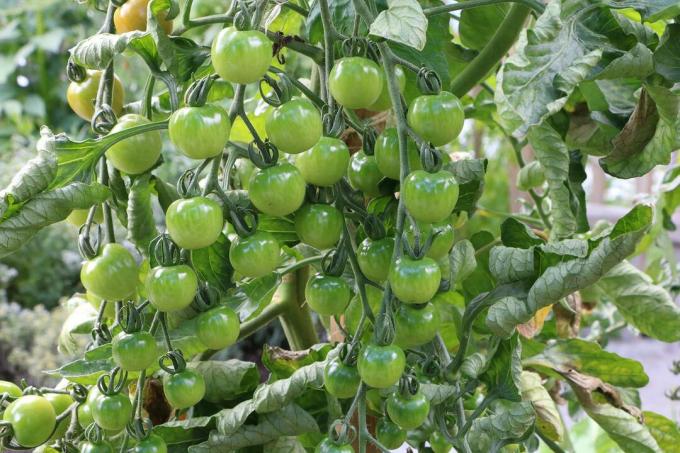
Table of contents
- Essential minerals
- Tomatoes fertilize in the development stages
- Frequency of fertilizing
- fertilizer selection
- Consequences of over- and under-fertilization
- Growth disorders (height or stunted stature)
- Discolored and deformed leaves
- Burnt roots or leaf edges
- Organic fertilizers for fertilizing tomatoes
- nettle manure
- compost
- worm tea
- Organic (liquid) fertilizer
- Supplementary fertilizer from home remedies
Tomatoes need a consistently high amount of nutrients for the development of flowers and fruits. In addition to choosing the right fertilizer, the amount and frequency also play an important role. All essential information for an optimal dosage can be found here.
A full supply of nutrients is essential for heavy consumers. Tomatoes therefore need fertilizer at regular intervals. This guarantees lush flowering and thus fruit development. It is also an important basis for a healthy immune system.
Essential minerals
A full supply of minerals is essential for many reasons. Among other things, it is necessary for a good immune system. In addition, it is also essential for lush fruit development. The following nutrients are required over the entire life cycle:
- calcium: 2.3 grams, essential for deacidification, excess leads to stunted growth, deficiency leads to alkalinity
- Potassium: 3.8 grams: essential for photosynthesis and fruit development, excess is harmless, deficiency for curled leaves and tasteless fruits
- Magnesium: 4 grams: essential for the water balance, excess is harmless, deficiency leads to yellowing of the leaves
- Phosphate: 0.5 grams: essential for all metabolic processes, excess is harmless, deficiency leads to yellow-brown leaves
- Sulfur: 0.7 grams: essential for the formation of enzymes and amino acids, excess leads to acidification, deficiency leads to yellowing of the leaves
- Nitrogen: 3 grams: Essential for chlorophyll formation and growth, excess leads to tall growth, deficiency leads to stunted stature

The requirements of the individual varieties may differ slightly from the above information. Therefore, find out about the exact conditions in advance.
Tomatoes fertilize in the development stages
The life cycle of the tomato plant consists of three developmental stages. Nutrient requirements vary by phase. It increases steadily with age.
- seedlings: no fertilization necessary
- young plants up to an age of two months: low nutrient requirements of one tenth of the listed values per single application of fertilizer
- adult plants: Consistently high nutrient requirement of four tenths of the listed values per single application of fertilizer
Frequency of fertilizing
How often the tomato plants have to be fertilized depends on their stage of development and on the variety. As mentioned earlier, no additional minerals should be added to seedlings just yet. Young plants should be slowly introduced to the regular fertilizer application every three weeks. Adult tomato plants need a new supply of nutrients about every two weeks.
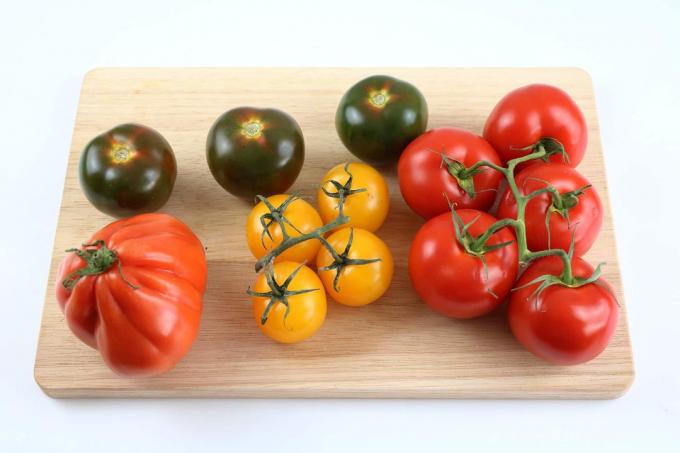
In relation to the individual variety, there may be slight differences in frequency. Particularly high-yielding varieties generally require more minerals. These species include Celsior, Siberian pear, black cherry, and sugar grape, among others. In contrast, genera that are descended from wild tomatoes tend to be undemanding.
fertilizer selection
In order to fertilize as naturally as possible, the use of an organic fertilizer is recommended. Alternatively, however, the use of a mineral fertilizer is also conceivable. However, this can lead to over-fertilization. Particular attention should therefore also be paid to the nutrient composition of the individual product. However, under-fertilization can also lead to serious impairments.
Consequences of over- and under-fertilization
Growth disorders (height or stunted stature)
Growth disorders are among the most common consequences of insufficient fertilization. The nutrient nitrogen is the main driver for the faulty development. Too high a proportion leads to uncontrolled growth in height. In contrast, undersupply leads to stunted growth. Regular external inspection of the plants is therefore essential. As soon as signs of unusual growth can be seen, the first measures should be taken. Water the plant liberally to flush out excess nutrients.
Discolored and deformed leaves
The discoloration of the leaves usually only occurs when there is insufficient supply. In addition to a lack of magnesium, phosphate and sulfur can also be the cause. Deformities are commonly due to a potassium shortage. It is often not possible to take an exact anamnesis if there is any damage. Therefore, feed the tomato a complete fertilizer that contains all the minerals.
Burnt roots or leaf edges
The burnt roots and leaf edges are also a common result of overfeeding. However, the solar radiation plays no role here. Due to a permanently increased nutrient concentration, the plant continuously loses liquid. This lack of water is reflected in burns on the roots and leaves. In this case, too, increased water intake is essential. However, parts of plants that have already been burnt cannot be restored.
Organic fertilizers for fertilizing tomatoes
nettle manure
Nettle slurry has been used as a natural tonic for many decades. The preparation of the brew is extremely simple and can be done in just a few steps.

- Chop 1 kilogram of fresh nettles or 200 grams of dried nettles
- Pour 10 liters of water over the nettles and stir vigorously
- optional: addition of rock flour to eliminate odors
- Close container airtight
- Stir daily for at least 10 to 14 days until no more bubbles appear
- Separate liquid from plant residues using a sieve
Before using the liquid manure, it must be diluted in a ratio of 1:10. The resulting mixture can then be distributed generously around the tomatoes every four weeks.
A notice:
Nettle stock is also suitable as a natural pesticide against aphids, spider mites and whiteflies.
compost
Compost is also one of the most natural fertilizers.
In addition to lawn and shoot cuttings, withered plants and plant remains can also be heaped up in the compost. The decomposition processes produce a nutrient-rich humus soil over time.
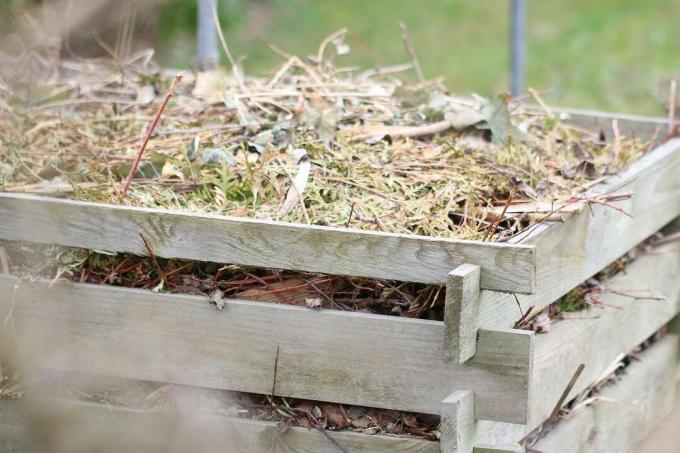
In order to get the greatest possible effect from the humus, it is advisable to fertilize a large area in autumn. For this purpose the compost evenly distributed in the bed. It is then incorporated into the existing soil. The microorganisms and nutrients contained can thus spread penetratingly until planting next year. Optionally, additional compost can be added in the spring.
Tip:
All animal remains such as bones and meat are not suitable for the compost. In addition, all kinds of processed substances are also not suitable for the hummus.
worm tea
Also known as compost tea, worm tea is a by-product of making compost with worms. However, its use is not nearly as widespread as that of humus. This is mainly due to the much more difficult extraction. When the compost is stored in a commercial composting area, the liquid continuously seeps into the ground. To catch them, a special worm composter needed. The materials to be composted are filled into this. The resulting liquid is then collected in the lower area of the container. With the help of a tap, it can be easily tapped off for use.
Due to the high nutrient density, fertilizing every four weeks is also recommended for the worm tea. Diluting the tea with additional water allows the liquid to be stretched. In this state, fertilization is also possible every two weeks.
A notice:
Alternatively, worm tea can be made from water, worm castings and molasses. The relevant materials can be purchased in specialist shops.
Organic (liquid) fertilizer
Organic fertilizers can also be purchased ready-made in stores. The nutrients are presented either in powder form, granulated or liquid. As a rule, however, the compositions differ only slightly from one another.
While solid variations have to be worked into the soil, adding liquid fertilizers to the irrigation water is sufficient. In terms of tradability, liquid fertilizers in particular are extremely popular. Precise information on the dosage is noted on the packaging. As a rule, regular fertilization every one to two weeks is recommended due to the short periods of action.
Supplementary fertilizer from home remedies
Basically, the aforementioned complete fertilizers offer the tomato plants all the important nutrients. However, an increased need for minerals can arise for various reasons. Examples are unfavorable site conditions or a disease.

In these cases, individual substances can be supplied inexpensively with the help of home remedies. It is important to note, however, that the following home remedies are only suitable as supplements. Sole fertilization is strongly discouraged.
- eggshell: contains calcium and magnesium
- coffee grounds: contains potassium and phosphorus
- Milk: contains calcium and phosphorus
- baking soda: contains sodium
 Home editorial office
Home editorial office
Learn more about tomatoes
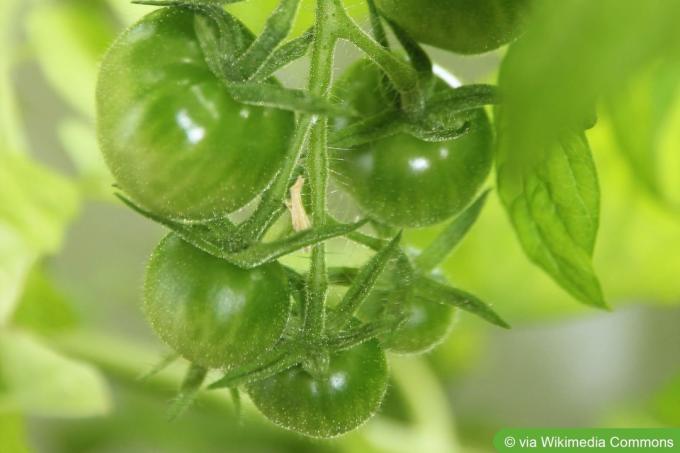
Mexican Honey Tomato: Taste & Cultivation
With the "Mexican honey tomato", hobby gardeners can bring a particularly sweet tomato variety into their garden. Due to its low acidity, it is one of the most popular sweet tomatoes and at the same time very easy to care for.
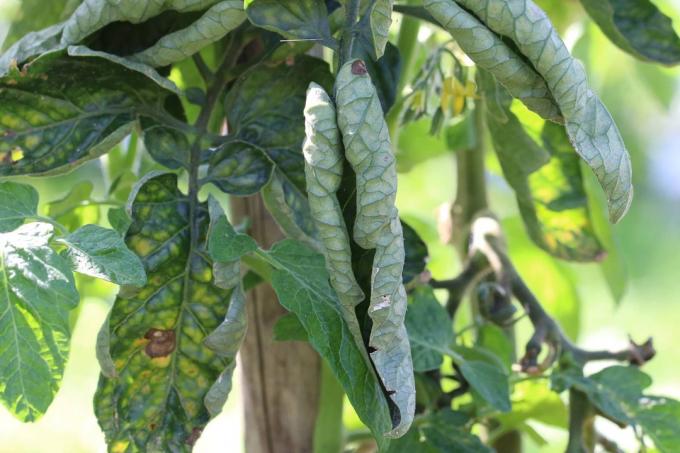
Tomato leaves curl: what to do?
There are many causes of curled leaves on tomato plants. Some are harmless, others can ruin crops. So waiting is not an option. Like a detective, you must search for clues. And then, if feasible, tailor-made countermeasures. Here's what to do when tomato leaves curl.
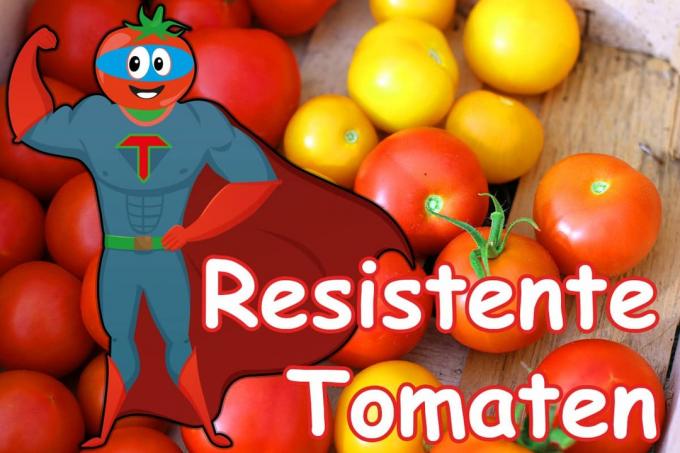
11 resistant tomato varieties defy rain and disease
Tomatoes are considered to be relatively easy to care for, but rain and numerous diseases can bother them. Fortunately, there are numerous tomato varieties that are resistant to many dreaded tomato diseases. We present the most popular specimens in this article.
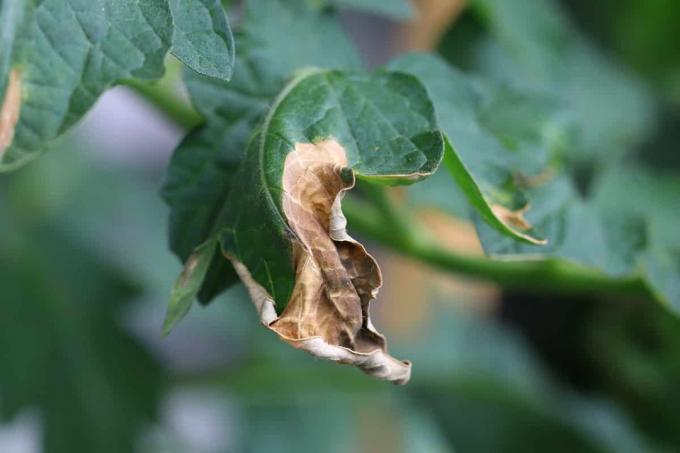
Control late blight and late blight in tomatoes
If pathogens of brown blight and late blight have settled on tomato plants, there is little hope of successful control. Home remedies and mechanical interventions only make sense in the early stages. It is all the more important that you prevent infections in a targeted manner through care measures.

How healthy are tomatoes? Information on calories, nutritional values & Co.
Snack healthy? The tomato makes it possible! Find out here why the red fruit should end up on the plate more often!
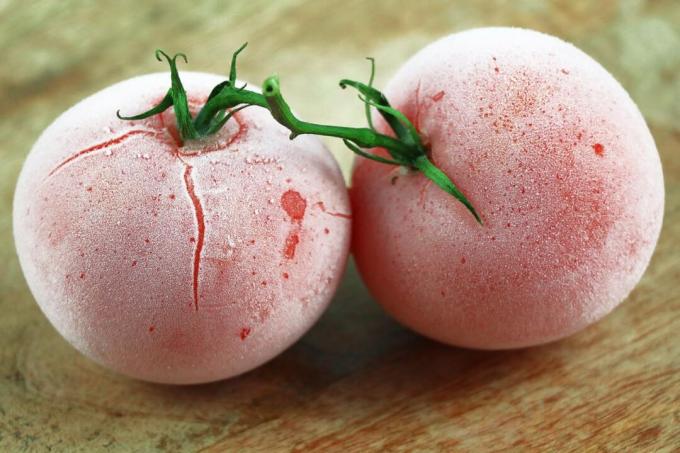
Autumn: what temperatures do tomatoes tolerate at night?
Tomatoes especially like it dry and warm in order to thrive. This means that the tomato plants can continue to ripen outside for a long time, even in a warm autumn. When the first frost comes, however, plants and fruits must be protected.

